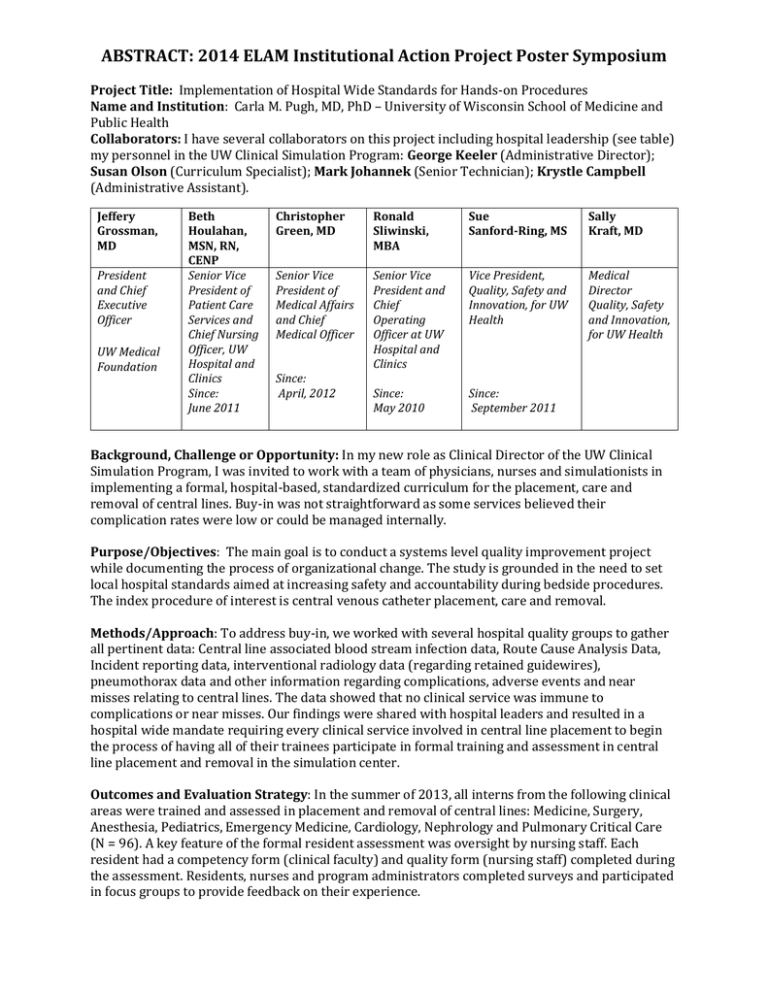ABSTRACT: 2014 ELAM Institutional Action Project Poster Symposium Project Title:
advertisement

ABSTRACT: 2014 ELAM Institutional Action Project Poster Symposium Project Title: Implementation of Hospital Wide Standards for Hands-on Procedures Name and Institution: Carla M. Pugh, MD, PhD – University of Wisconsin School of Medicine and Public Health Collaborators: I have several collaborators on this project including hospital leadership (see table) my personnel in the UW Clinical Simulation Program: George Keeler (Administrative Director); Susan Olson (Curriculum Specialist); Mark Johannek (Senior Technician); Krystle Campbell (Administrative Assistant). Jeffery Grossman, MD President and Chief Executive Officer UW Medical Foundation Beth Houlahan, MSN, RN, CENP Senior Vice President of Patient Care Services and Chief Nursing Officer, UW Hospital and Clinics Since: June 2011 Christopher Green, MD Ronald Sliwinski, MBA Sue Sanford-Ring, MS Sally Kraft, MD Senior Vice President of Medical Affairs and Chief Medical Officer Senior Vice President and Chief Operating Officer at UW Hospital and Clinics Vice President, Quality, Safety and Innovation, for UW Health Medical Director Quality, Safety and Innovation, for UW Health Since: May 2010 Since: September 2011 Since: April, 2012 Background, Challenge or Opportunity: In my new role as Clinical Director of the UW Clinical Simulation Program, I was invited to work with a team of physicians, nurses and simulationists in implementing a formal, hospital-based, standardized curriculum for the placement, care and removal of central lines. Buy-in was not straightforward as some services believed their complication rates were low or could be managed internally. Purpose/Objectives: The main goal is to conduct a systems level quality improvement project while documenting the process of organizational change. The study is grounded in the need to set local hospital standards aimed at increasing safety and accountability during bedside procedures. The index procedure of interest is central venous catheter placement, care and removal. Methods/Approach: To address buy-in, we worked with several hospital quality groups to gather all pertinent data: Central line associated blood stream infection data, Route Cause Analysis Data, Incident reporting data, interventional radiology data (regarding retained guidewires), pneumothorax data and other information regarding complications, adverse events and near misses relating to central lines. The data showed that no clinical service was immune to complications or near misses. Our findings were shared with hospital leaders and resulted in a hospital wide mandate requiring every clinical service involved in central line placement to begin the process of having all of their trainees participate in formal training and assessment in central line placement and removal in the simulation center. Outcomes and Evaluation Strategy: In the summer of 2013, all interns from the following clinical areas were trained and assessed in placement and removal of central lines: Medicine, Surgery, Anesthesia, Pediatrics, Emergency Medicine, Cardiology, Nephrology and Pulmonary Critical Care (N = 96). A key feature of the formal resident assessment was oversight by nursing staff. Each resident had a competency form (clinical faculty) and quality form (nursing staff) completed during the assessment. Residents, nurses and program administrators completed surveys and participated in focus groups to provide feedback on their experience. Implementation of Hospital Wide Standards for Hands-on Procedures Background Carla M. Pugh, MD, PhD • There was a hospital wide review of UW Health sentinel events relating to central line placement, maintenance and removal. Key Issues • Review of University of Wisconsin Hospital and Clinics (UWHC) data on adverse events associated with central lines. • Update on newly implemented central line training and assessment experience. • Discussion on setting clinical standards at UWHC • The main questions posed to the council during this first meeting include: • This year all incoming residents in Surgery, Anesthesia, Emergency Medicine, Pediatrics, Cardiology, Nephrology, Pulmonary critical care and Internal Medicine participated in a standardized training curriculum and assessment regarding central lines. 1. Which standards should be implemented? Ultrasound? Bundle? 2. Is the central line bundle standard good enough? 3. Should all providers be required to use ultrasound guided techniques for IJ and femoral? 4. Should faculty be held to the same standards as residents and fellows? Purpose • Implement hospital wide standards for bedside procedures. Next Steps • Use central line placement as an index case to review and outline the process of implementation for all procedures. • The next step involves implementation. The major hurdle here will be training the nurses to assume the quality oversight role and developing an IT solution that allows for web-based credential checking. This will allow the nurses to ensure the clinician has satisfactorily completed training before interacting with a live patient. Stakeholders PRESENTED AT THE 2014 ELAM® LEADERS FORUM (II)



